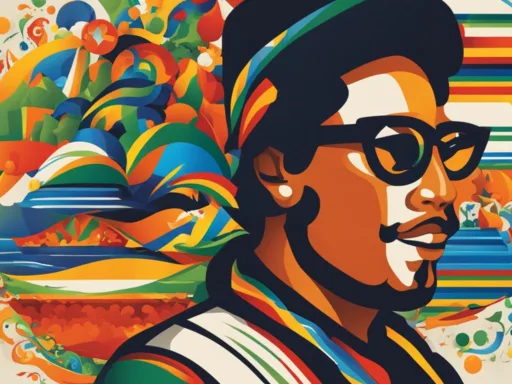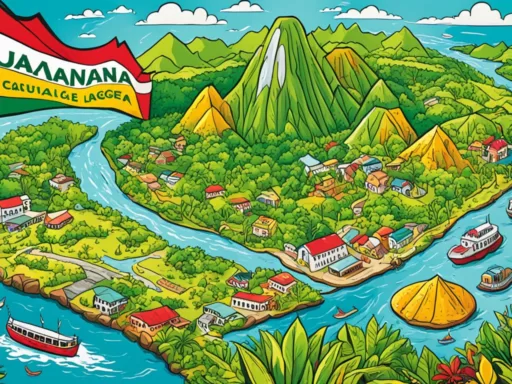In the heart of South America, a linguistic phenomenon unfolds—over 88% of Uruguay’s population speaks a unique dialect of Spanish infused with an Italian twist. This remarkable statistic highlights just how deeply languages spoken in Uruguay are intertwined with the country’s culture and history. While Spanish reigns supreme as the most widely spoken language in Uruguay, visitors will encounter a rich tapestry of dialects and languages that contribute to Uruguay’s language culture.
Travel guides often remind visitors that a basic understanding of Spanish can tremendously enhance their experience in this diverse nation. Tools like Rosetta Stone or Duolingo provide accessible means to grasp essential Spanish phrases, opening doors to more meaningful interactions with the locals. Embrace the opportunity to greet with a warm “Hola” or express your gratitude with “Gracias”, knowing that these are more than mere words—they’re a passport to the heart of Uruguayan sociability.
Key Takeaways
- Spanish, laced with Italian influences, is the official and most widely spoken language in Uruguay.
- The unique Uruguayan dialect, distinguishable from its neighbors, adds to the rich Uruguay language culture.
- Learning key Spanish expressions can significantly enhance interaction and travel experiences within Uruguay.
- Language learning tools such as Duolingo and Rosetta Stone are helpful for visitors to get acquainted with basic Spanish phrases.
- English is less prevalent but gaining traction in tourist areas and higher education within the country.
- The intermingling of languages spoken in Uruguay reflects the country’s layered history and influences from European immigration.
The Rich Tapestry of Languages Spoken in Uruguay
The linguistic landscape of Uruguay is as varied and vibrant as its history, painting a portrait of cultural convergence and diversity. At its core, the official languages in Uruguay highlight a story of migration and adaptation, where voices from distant lands have weaved into the country’s social fabric. It’s a place where the echo of indigenous languages of Uruguay underlines a somber past of territorial and cultural shifts. Now, let’s delve deeper into the Italian infusion within Uruguayan Spanish, an influence that has lent this dialect a touch of Mediterranean charm.
Examining the Influence of Italian on Uruguayan Spanish
In the alleys of Montevideo and across the Uruguayan plains, Spanish is spoken with a certain Italian gusto. This is not by chance—the nation has been significantly shaped by Italian immigrants, whose linguistic fingerprints are deeply embedded in the vernacular of Uruguay. These European influences are not just residual; they actively shape the way the language is spoken today, with Italian words and expressions frequently interspersed in daily communication.
The Significance of Rioplatense Spanish in Local Culture
Rioplatense Spanish stands as a symbol of both Uruguay and Argentina’s shared cultural heritage. Its unique blend of Spanish with Italian nuances creates a dialect that is music to the ears—lilting, expressive, and intimately tied to the region’s identity. Whether through the lyrical intonation or the distinctive slang, Rioplatense Spanish is a living testament to Uruguay’s European ties and a focal point of national pride.
Other European Languages Present in the Uruguayan Linguistic Landscape
Yet, Spanish and Italian are not the sole representatives of Uruguay language diversity. German, Portuguese, and French communities contribute to the polyglot nature of the country. Despite their smaller numbers, these language groups maintain their tongues through cultural associations, schools, and social activities, thereby enriching the national mosaic of languages.
| Language | Ancestry | Usage in Uruguay | Cultural Significance |
|---|---|---|---|
| Spanish (official) | Spanish Colonization | Widely spoken throughout the country | National identity, everyday communication |
| Italian | Italian Immigration | Inflections in everyday Spanish | Hospitality, cuisine, family traditions |
| Portuguese | Brazilian Proximity | Border regions, bilingual speakers | Trade, cross-border relations |
| German | European Immigration | Minority communities, heritage speakers | Educational institutions, cultural clubs |
Through this intricate interlocking of cultures and tongues, Uruguayans navigate a world where language is both a bridge to the past and a vessel for contemporary expression. It’s a testament to the resilience of cultural identity and the unyielding tapestry of voices that define a nation’s soul.
Understanding Uruguay’s Official Language: Spanish
The rich tapestry of languages spoken in Uruguay paints a picture of cultural and historical amalgamation, where the influence of European legacy resonates deeply within the nation’s linguistic landscape. At the heart of this lies the robust dominance of the Spanish language, an enduring testament to Uruguay’s colonial past and its evolution as an independent state. In Uruguay’s societal discourse, Spanish operates not only as a communicative tool but as a marker of national identity, thereby holding the prestigious title of one of the official languages in Uruguay.
Travelers, scholars, and citizens alike find themselves immersed in a version of Spanish that is uniquely Uruguayan, echoing through bustling city streets and tranquil seaside resorts. This Spanish dialect is enlivened with Italian nuances, the remnants of a migration pattern that left indelible marks on the pronunciation and vocabulary of the country’s spoken language. Currently, over 90% of Uruguayans fluently converse in this charmingly accented Spanish, which stands as a unifying voice from the historical quarters of Colonia del Sacramento to the modern avenues of Montevideo.
English, while noted as a significant foreign language within educational domains and tourist hotspots, lacks the pervasive presence that Spanish commands. Its utilization reflects an increasingly interconnected world where English serves as the proverbial bridge between global cultures, yet remains within the confines of academic circles and professional environments. As such, a visitor’s engagement with the heart of Uruguayan culture lies in embracing the rhythm and warmth of its Spanish dialect.
Despite the linguistic dominance of Spanish, the Uruguayan spirit of inclusivity and cultural reverence opens its doors to other languages, recognizing the value each adds to the rich tapestry of the nation’s identity. With Spanish at its core, Uruguay stands proud in its linguistic heritage, offering an inviting blend of tradition and modernity in its spoken words.
The Italian Influence on Uruguay’s Spanish Dialect
The interweaving of Italian flavor into the fabric of Uruguayan Spanish is not merely a linguistic curiosity but stands as a testament to the powerful cultural forces of migration and assimilation. Across the streets of Uruguay, the echoes of Italy are heard, not just in the names of food and family but in the very rhythm of everyday conversation. This section explores how Italian lexicon has become a staple in languages spoken Uruguay, particularly in Uruguayan Spanish, and delves into Italy’s linguistic impact in Uruguay—a country where the past and present converge with a unique Mediterranean twist.
Integrating Italian Vocabulary into Everyday Speech
In Uruguay, the convergence of Spanish and Italian has given rise to a dialect rich in history and character. It is common to hear Italian words sprinkled amidst Spanish conversations, a reflection of the blending cultures. Below is a selection of Italian-derived words commonly used in Uruguay, each with its own backstory of integration into the local vernacular.
- Nono – Meaning grandfather, a term of endearment for family patriarchs
- Fainá – A chickpea flour dish that has become a beloved staple
- Ciao – An informal farewell, as friendly on Uruguayan lips as it is in Italy
- Pasta – Beyond food, pasta represents a shared cultural heritage
The Legacy of Italian Immigrants in Local Vernacular
Italian immigrants have imprinted upon the very essence of the Uruguayan language, leaving behind a legacy traceable through the vibrant tapestry of the modern Uruguayan Spanish. The resonance of Italy’s linguistic impact in Uruguay is more than a historical footnote; it is a living, breathing element of daily life.
| Italian Word | Meaning in Spanish | Uruguayan Usage |
|---|---|---|
| Nono | Abuelo (Grandfather) | Term of affection for one’s grandfather |
| Fainá | Tortilla de garbanzos (Chickpea flour crêpe) | Popular dish often enjoyed with pizza |
| Ciao | Adiós (Goodbye) | Casual farewell among friends |
| Pasta | Pasta | Culinary term, also encompasses a cultural connection |
It’s clear that the allure of Italy is ever-present on the streets of Uruguay, from the cherished family table to the colloquialisms that pepper daily talk. The Italian impact on the linguistic landscape of this South American nation is a poignant reminder of the enduring bonds formed through language and heritage. In every melodious turn of phrase, Uruguay honors its forebears, ensuring that their voices continue to shape the country’s vibrant linguistic identity.
Indigenous Languages of Uruguay: A History of Loss and Preservation
The story of indigenous languages in Uruguay is a poignant chapter in the nation’s historical tapestry. Spanish colonization dramatically altered the linguistic landscape, leading to the unfortunate decline of Uruguay’s indigenous tongues. The Charrúa, Guaraní, and Chaná peoples once spoke vibrant languages reflecting a deep connection to the land and their cultures. However, the cultural assimilation and displacement faced during colonial times led to a profound loss, relegating these languages to mere echoes of the past.
Today, recognizing and honouring Uruguay’s historical languages is not just an act of remembrance but a crucial step toward cultural preservation. Initiatives are in motion to reclaim and revitalize remnants of these languages, although the task remains daunting. Small academies, passionate linguists, and dedicated cultural groups are making strides in this direction, aiming to breathe new life into languages that once resonated across Uruguay’s plains and hills.
- Language documentation: Compiling dictionaries and grammatical records for educational and cultural dissemination.
- Community engagement: Encouraging local communities to participate in language revitalization efforts.
- Cultural legacy projects: Establishing programs that integrate indigenous languages into art, music, and storytelling.
In the spirit of language preservation in Uruguay, the country’s education system has begun to acknowledge the value of its linguistic roots. By integrating aspects of indigenous language and culture into curricula, there is hope for these languages to gain a foothold once again. Though the task is immense, the commitment to preserving and reinvigorating these languages speaks to a broader movement to safeguard intangible cultural heritage globally.
Reviving a language is reviving a worldview. It’s a gateway to understanding the philosophy, the wisdom, and the living practices of a culture profoundly connected to its environment.
As the world becomes increasingly globalized, the importance of cherishing linguistic diversity cannot be overstated. Uruguay’s example is a compelling testimony to the resilience of cultural identity and the power of collective memory. While the echoes of Uruguay’s indigenous languages may be faint, their spirit endures, inspiring a new generation of Uruguayans to explore and cherish their ancestral linguistic heritage.
Foreign Languages in Uruguay: From English to German
While Uruguay is historically linked to its Spanish roots, the linguistic landscape is being coloured by a spectrum of foreign languages, reflecting the nation’s changing social and economic milieu. With the intensifying waves of global tourism and the reach of globalization, establishments across Uruguay are increasingly embracing languages such as English, German, and even French to facilitate communication and business.
The Role of Tourism and Globalization
One cannot overlook the dynamic relationship between tourism and the proliferation of global languages in Uruguay. The picturesque beaches of Punta del Este and the cultural vibrance of Montevideo are attracting a global audience. In response, the hospitality sector is recognizing the advantages of offering services in multiple languages, making English and German common communication tools aimed at improving visitor experiences and expanding market reach.
Education and the Prevalence of English Language Learning
In the education realm, there’s a noteworthy trend towards English language learning in Uruguay, especially as English is recognized universally as a lingua franca of business and diplomacy. Montevideo’s educational institutions, from primary schools to universities, are prioritizing English as a second language, understanding its vital role in students’ future global interactions and career opportunities.
| Language | Importance | Areas of Influence | Learning Platforms |
|---|---|---|---|
| English | Business, Tourism, Education | Urban Centers, Hospitality, Schools | Language Centers, Online Courses |
| German | Cultural Exchanges, Immigrant Communities | Community Schools, Cultural Associations | Goethe-Institut, Private Tutoring |
| French | Diplomacy, Arts | Embassies, Cultural Institutes | Alliance Française, Multimedia Resources |
The importance of languages like German and French is also coming to light, albeit through niche sectors such as historical immigrant communities and diplomatic fronts. Foreign languages in Uruguay are thus not just a bridge to international affairs but are becoming integrated into the societal fabric, offering a window to diverse opportunities and cultural expansions.
Language Diversity and Its Reflection on Uruguay’s Society
The vibrant tapestry of Uruguay language diversity paints a vivid picture of the nation’s historical narrative and contemporary cultural fabric. With linguistic influences that span from the indigenous to the far-reaching corners of Europe, Uruguay has cultivated a unique cultural multilingualism. This rich blend of languages not only colors daily communication but also plays a pivotal role in shaping national identity and language in Uruguay.

Cultural Expression Through Multilingualism
Uruguay’s embrace of multiple languages goes beyond simple communication—it’s a form of cultural expression that resonates through the arts, media, and everyday interactions. Celebrations of multilingualism illuminate festivals and theaters across the country, reinforcing the notion that language is a living feature of Uruguay’s cultural landscape.
The Impact of Linguistic Diversity on National Identity
In Uruguay, language diversity is more than a characteristic of the population—it’s the thread that weaves together the fabric of national identity. The harmonious coexistence of various languages within the country deepens the sense of community and belonging. It stands as a testament to the nation’s open-mindedness, resilience, and inclusive spirit, reflecting the collective character of Uruguay’s people.
Most Widely Spoken Languages in Uruguay Beyond Spanish
While the Spanish language prevails in Uruguay, linguistic diversity is noted for adding cultural richness to the nation’s profile. Crucially, the interaction with neighboring Brazil has given rise to a unique linguistic phenomenon and the amalgamation of cultural elements that shape the communicative fabric of border communities.
Portuñol: A Unique Blend at the Brazilian Border
Portuñol, a linguistic bridge between Spanish and Portuguese, is an extraordinary testament to the fluidity of language. This hybrid tongue thrives in the border regions, serving as a practical communication tool for both Uruguayans and Brazilians. It encapsulates a fascinating cultural interexchange, forming a particular linguistic identity that is not found anywhere else.
The Presence of Portuguese in Everyday Communication
Alongside Portuñol, the Portuguese language influence in Uruguay is unmistakable, especially in northern areas like Rivera. Residents navigate a bilingual reality, with Portuguese peppering their daily interactions. In these locales, one can expect to hear Portuguese at markets, schools, and amidst the convivial banter on the streets, a clear reflection of the linguistic symbiosis with Brazil. The melding of Spanish and Portuguese not only adds to the cultural tapestry but also enriches the most widely spoken languages in Uruguay.
Rioplatense Spanish: Uruguay’s Unique Spanish Dialect
Within the rich tapestry of Latin American Spanish variants, Rioplatense Spanish stands as a distinct and vibrant thread. This linguistic flourish exemplifies the uniqueness of Spanish dialects in Uruguay, mirroring the cultural landscape of the Rio de la Plata basin. Our journey into the idiosyncratic world of Rioplatense Spanish reveals its charming peculiarities, contrasting with other Latin American vernaculars.

Characteristics of Rioplatense Spanish
Rioplatense Spanish, recognized for its melodic intonation and colloquialisms, is a living tableau of Uruguay’s historical ties with Europe. One of its hallmarks is the use of the pronoun “vos” as a casual form of address, replacing the standard “tú,” and ubiquitously permeates everyday conversation. Also integral to its singularity is the selective adaptation of American English technical terms, a trait less observed in other Hispanic nations.
Comparison with Spanish Variants Across Latin America
When contrasted with other Latin American Spanish variants, Rioplatense’s European flair and lexical borrowings are notable. Adjacent countries like Peru or Mexico maintain lexicons more reflective of traditional Spanish, while Uruguayans revel in an eclectic linguistic mixture reflective of their rich cultural tapestry.
| Feature | Rioplatense Spanish (Uruguay) | Standard Latin American Spanish | Castilian Spanish (Spain) |
|---|---|---|---|
| Informal “You” | Vos | Tú | Tú/Vosotros |
| Plural “You” | Ustedes | Ustedes | Vosotros |
| Linguistic Influence | Italian/Meridional Spanish | Indigenous/American Spanish | Castilian |
| Technical Terms | American English | Varied, less direct borrowing from American English | British English/French |
In exploring Rioplatense Spanish, we unearth the distinctness of this cultural jewel, highlighting the fluidity and versatility of language as it adapts to time, terrain, and society. It’s clear that Uruguay’s unique Spanish dialects serve not only as a mode of communication but as a cultural identifier within the grand chorus of Latin American voices.
The Importance of Language in Uruguay’s Cultural Identity
The intricate weavings of Uruguay language culture form the centerpiece of the nation’s cultural identity in Uruguay, symbolizing a collective persona that is vibrant and resonant with historical undertones. It is through the medium of language that one can truly grasp the essence of Uruguay’s varied and complex cultural tapestry. Embedded deeply within every aspect of Uruguayan life, from local cuisines to the rhythms of Candombe, language is a potent emblem of linguistic cultural identity.
A harmonious blend of influences has given rise to a unique linguistic identity, an identity framed not just by words but by the shared experiences and customs that those words express. To understand the Uruguayan spirit, one must listen to the symphony of sounds that course through its cities, fields, and along the coastlines where the Rio de la Plata kisses the shores.
Let us consider the following table to see how various aspects of language deeply influence Uruguay’s cultural identity:
| Aspect of Culture | Influenced by Language | Example |
|---|---|---|
| Cuisine | Italian and Spanish Terms | Fainá, Asado |
| Music | Afro-Uruguayan and European Terms | Candombe, Milonga |
| Dance | Terminology Reflecting History and Blend of Cultures | Tango, Murga |
| Literature | Use of Rioplatense Spanish | Gaucho Literature |
| Social Interactions | Italian Gestures and Spanish Formality | Usage of voseo, Open Expression |
Beyond the spoken words, gestures, and expressions indicative of Italian descent are interwoven into the way Uruguayans communicate. The gemination of consonants, a trait derived from Italian, punctuates conversations with a rhythm unique to Uruguayan Spanish, further cementing the nation’s linguistic cultural identity.
Through language, Uruguayans maintain a bridge to their past while charting a path forward, balancing the heritage of yesteryears with the dynamism of contemporary society. In Uruguay, language is not merely a tool for communication but a celebration of culture, a means of expressing the inherent diversity that makes up its rich societal fabric.
In summary, the role of language within Uruguay’s culture is profoundly significant. It is a potent conduit for expressing and preserving the nation’s unique history, traditions, and social mores. As the people of Uruguay continue to speak, they do so not just to be heard, but to keep the story of their cultural identity vibrantly alive.
Modern Language Education in Uruguay
Uruguay’s commitment to language education is evident in its comprehensive approach to incorporating languages such as Spanish, English, and Portuguese into the educational system. In a world where communication boundaries are increasingly blurred, Uruguay has recognized the importance of modern language instruction and has taken proactive steps to integrate it into both primary and higher education.
Learning Languages in Schools and Universities
Components of language education in Uruguay flourish within the network of primary schools, secondary institutions, and universities across the country. Spanish, as the native tongue, is of course given prominence, but the study of English and Portuguese is becoming increasingly standard. This trilingual approach is preparing students for a globalized workforce, where linguistic versatility is highly valued.
Technology and Language Learning: Leveraging Digital Tools
The digital era has ushered in innovative language learning technology that is transforming the way knowledge is acquired. In Uruguay, educators are utilizing technology-driven tools to offer a more interactive and engaging language learning experience. Through the use of language software and applications, learners are equipped with the means to practice and hone their language skills with immediate feedback and a personalized pace.

Notable examples of language learning platforms include Duolingo and Babbel, which have found their way into many Uruguayan classrooms and households. These platforms often act as complementary tools to traditional language instruction methods.
| Language | School Integration | Technology Integration |
|---|---|---|
| Spanish | Core instruction in all schools | Use of digital exercises and multimedia resources |
| English | Compulsory subject in many schools; focus on bilingual education in some regions | Interactive software for grammar and vocabulary; Online resources and e-books |
| Portuguese | Commonly taught, particularly in areas near Brazilian border | Online conversation classes; Language exchange apps |
As Uruguay moves forward, its embrace of modern language instruction and learning technology is positioning the nation as a model for innovative education in South America. The combination of traditional and digital education methodologies supports a robust language education infrastructure, providing Uruguayans with the vital communication tools necessary for thriving in a multilingual world.
Conclusion
Uruguay’s linguistic heritage is as colorful and nuanced as its vibrant culture, a canvas painted with the broad strokes of the Spanish language, embellished with the delicate detailing of Italian influence, and highlighted by the distinct patterns of Rioplatense. This plethora of languages spoken in Uruguay transcends mere communication—it is the lifeblood of national identity, an identity enriched by diversity and expressed through every interaction.
As we have delved into the nation’s dialogues, it becomes clear that embracing language diversity in Uruguay is more than an ideal; it is an everyday reality. The interplay of various tongues not only sets a stage for inclusiveness but also forges a link between the past and the present, showcasing Uruguayan society’s commitment to honoring its roots while forging ahead in a globalized world.
In conclusion, Uruguay shows us that language is not just a tool for conversation; it is a symbol of heritage, a conduit for culture, and a key to understanding a nation’s heart and soul. In the rich tapestry of languages that adorn the Uruguayan landscape, there lies a story of unity and pride, beckoning us to listen, learn, and appreciate the melodious symphony of human expression.






